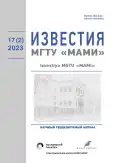Influence of switching sequences on the neutral point voltage balance in a three-level voltage source invertor
- Authors: Shishkov A.N.1, Dudkin M.M.2, Le V.1
-
Affiliations:
- Moscow Polytechnic University
- South Ural State University (National Research University)
- Issue: Vol 17, No 2 (2023)
- Pages: 195-206
- Section: Electrotechnical facilities and systems
- URL: https://journals.rcsi.science/2074-0530/article/view/253976
- DOI: https://doi.org/10.17816/2074-0530-125204
- ID: 253976
Cite item
Full Text
Abstract
BACKGROUND: Ensuring the voltage balance of the neutral point of the DC link within acceptable limits is one of the mandatory requirements during the operation of a three-level autonomous neutral point clamped voltage source inverter. It is known that neutral point voltage imbalance can adversely affect the operation of the inverter and the load at all, lead to the failure of both power switches and capacitors in the DC link. Neutral point voltage imbalance mostly often occurs due to the asymmetry of the nominal values of DC capacitors, inconsistent properties of switching devices, asymmetric three-phase load, and also due to the imperfection of the converter control algorithm.
AIMS: Selection of the optimal switching sequence that ensures the smallest deviation of the neutral point voltage and the number of switching of power switches in a three-level voltage source inverter.
METHODS: For an objective comparison of the considered switching sequences and their influence on the neutral point voltage balance, a simulation model of a three-level neutral point clamped voltage source inverter was developed in the MATLAB/Simulink software. To control this inverter, a space vector modulation method was used with three different switching sequences: five-segment, seven-segment and standard.
RESULTS: The topology of a three-level neutral point clamped voltage source inverter is presented. The experimental dependencies of the neutral point voltage deviation error was taken with a change in the modulation coefficient, the frequency of the fundamental harmonic at the inverter output, and load characteristics for three different switching sequences.
CONCLUSIONS: In this paper, the influence of the basic vectors and the influence of switching sequences on the neutral point voltage balance are studied. Combinations of states of large and zero basic vectors do not affect the neutral point voltage. For the medium basic vectors, the neutral point voltage can increase or decrease depending on the operating conditions of the inverter. The small basic vectors significantly affect the neutral point voltage. Considering the abovementioned, the seven-segment sequence that ensures both the optimal balance of the neutral point voltage and the level of switching losses should be considered as the best switching sequence for a three-level inverter.
Full Text
##article.viewOnOriginalSite##About the authors
Alexander N. Shishkov
Moscow Polytechnic University
Email: shan1982@mail.ru
ORCID iD: 0000-0001-9851-8745
SPIN-code: 5099-9286
Scopus Author ID: 43861781400
ResearcherId: A-4517-2014
Cand. Sci. (Tech.), Head of the Electrical Equipment and Industrial Electronics Department
Russian Federation, 38 Bolshaya Semenovskaya street, 107023 MoscowMaxim M. Dudkin
South Ural State University (National Research University)
Email: dudkinmax@mail.ru
ORCID iD: 0000-0003-4876-8775
SPIN-code: 5703-3117
Scopus Author ID: 55755728100
Dr. Sci. (Tech.), Professor of the Electric Drives, Mechatronics and Electromechanics Department
Russian Federation, 76, V.I. Lenin Ave., Ural Federal District, 454080 ChelyabinskVan Kan Le
Moscow Polytechnic University
Author for correspondence.
Email: canhlv.mta@gmail.ru
ORCID iD: 0009-0007-5183-6077
Postgraduate of the Electrical Equipment and Industrial Electronics Department
Russian Federation, 38 Bolshaya Semenovskaya street, 107023 MoscowReferences
- Gorozhankin AN, Dudkin MM. Algorithms and Control Systems for Electric Drives of Cold Pipe-Rolling Mills. Russian Electrical Engineering. 2020;91(7):440–446. doi: 10.3103/s1068371220070068
- Dudkin MM. Energy-saving technologies in test benches using single-phase reversible converters. Vestnik YuUrGU. Seriya «Energetika». 2013;13(1):5–18. (in Russ.)
- Khramshim RR, Khramshin TR, Khramshina EA, et al. Multilevel high-voltage frequency converter for electric drive. Izvestiya Tulskogo gosudarstvennogo universiteta. Tekhnicheskie nauki. 2010:191-196. (in Russ.)
- Donskoy N, Ivanov A, Matison V, et al. Multilevel autonomous inverters for electric drive and electric power industry. Silovaya Elektronika. 2008;1:43-46. (in Russ.)
- Makarov VG, Khaybrakhmanov RN. Multilevel voltage inverters. Topology overview and application. Vestnik tekhnologicheskogo universiteta. 2016;19(22):134-138. (in Russ.)
- Lazarev SA. Application of voltage inverters in high-voltage electric drive. Ekspozitsiya Neft Gaz. 2013:31-35. (in Russ.)
- Peddapelli SK. Pulse Width Modulation: Analysis and Performance in multilevel inverter. Oldenbourg: De Gruyter Oldenbourg; 2017.
- Holmes GD, Lipo TA. Pulse Width Modulation for Power Converters: Principles and Practice. New York: Wiley-IEEE Press; 2003.
- Choi U-M, Lee K-B. Neutral-Point Voltage Balancing Method for Three-Level Inverter Systems with a Time-Offset Estimation Scheme. Journal of Power Electronics. 2013;13(2):243–249. doi: 10.6113/JPE.2013.13.2.243
- Abulveleev IR, Khramshin TR, Kornilov GP, et al. Principles of constructing vector pulse-width modulation for a three-level inverter. Elektrotekhnicheskie sistemy i kompleksy. 2016;4(33):72-77. (in Russ.)
- Busquets-Monge S, Bordonau J, Boroyevich D, et al. The nearest three virtual space vector PWM - a modulation for the comprehensive neutral-point balancing in the three-level NPC inverter. IEEE Power Electronics Letters. 2004. Vol. 2, N 1. doi: 10.1109/LPEL.2004.828445
- Gelman MV, Dudkin MM. Valve converters of direct and alternating current. Chelyabinsk: Izd. tsentr Yuzhno-Uralskogo gosudarstvennogo universiteta; 2013. (in Russ.)
- Lewicki A, Krzeminski Z, Abu-Rub H. Space-Vector Pulse width Modulation for Three-Level NPC Converter With the Neutral Point Voltage Control. IEEE Transactions on Industrial Electronics. 2011;58(11):5076-5086. doi: 10.1109/TIE.2011.2119453
- Koyama M, Fujii T, Uchida R, et al. Space voltage vector-based new PWM method for large capacity three-level GTO inverter. In: Proceedings of the 1992 International Conference on Industrial Electronics, Control, Instrumentation, and Automation. San Diego: IEEE; 1992:271-276. doi: 10.1109/IECON.1992.254621.
Supplementary files




















